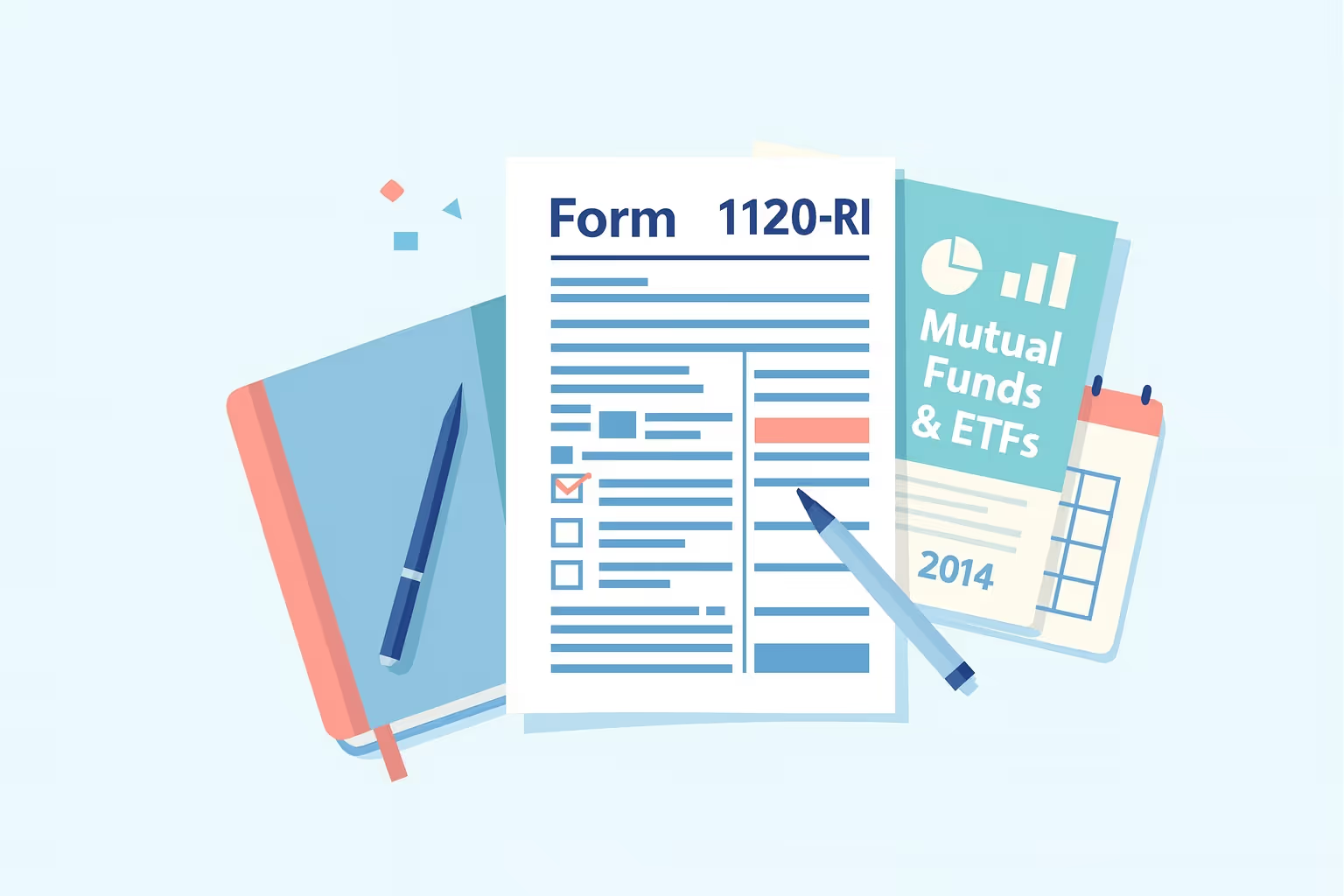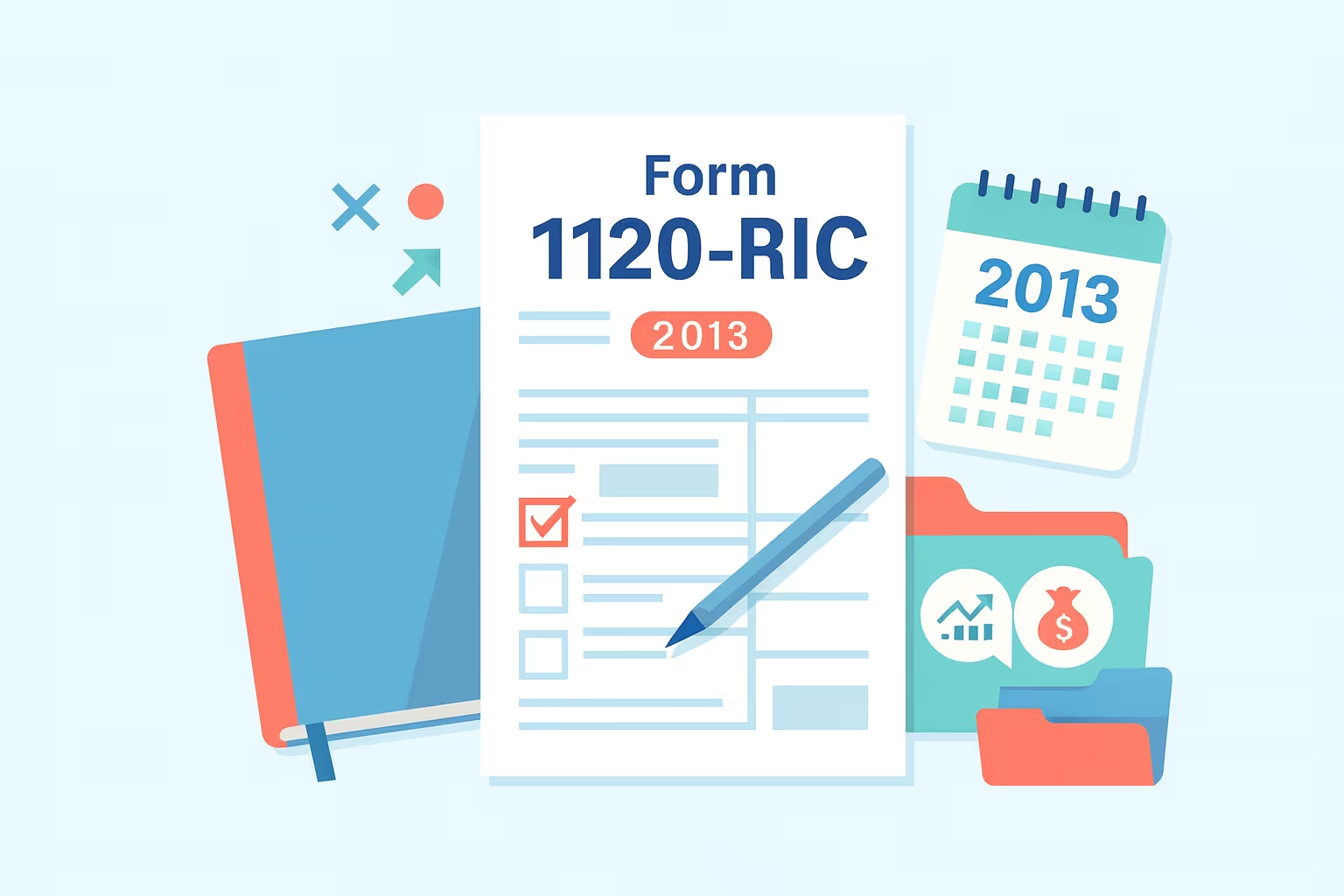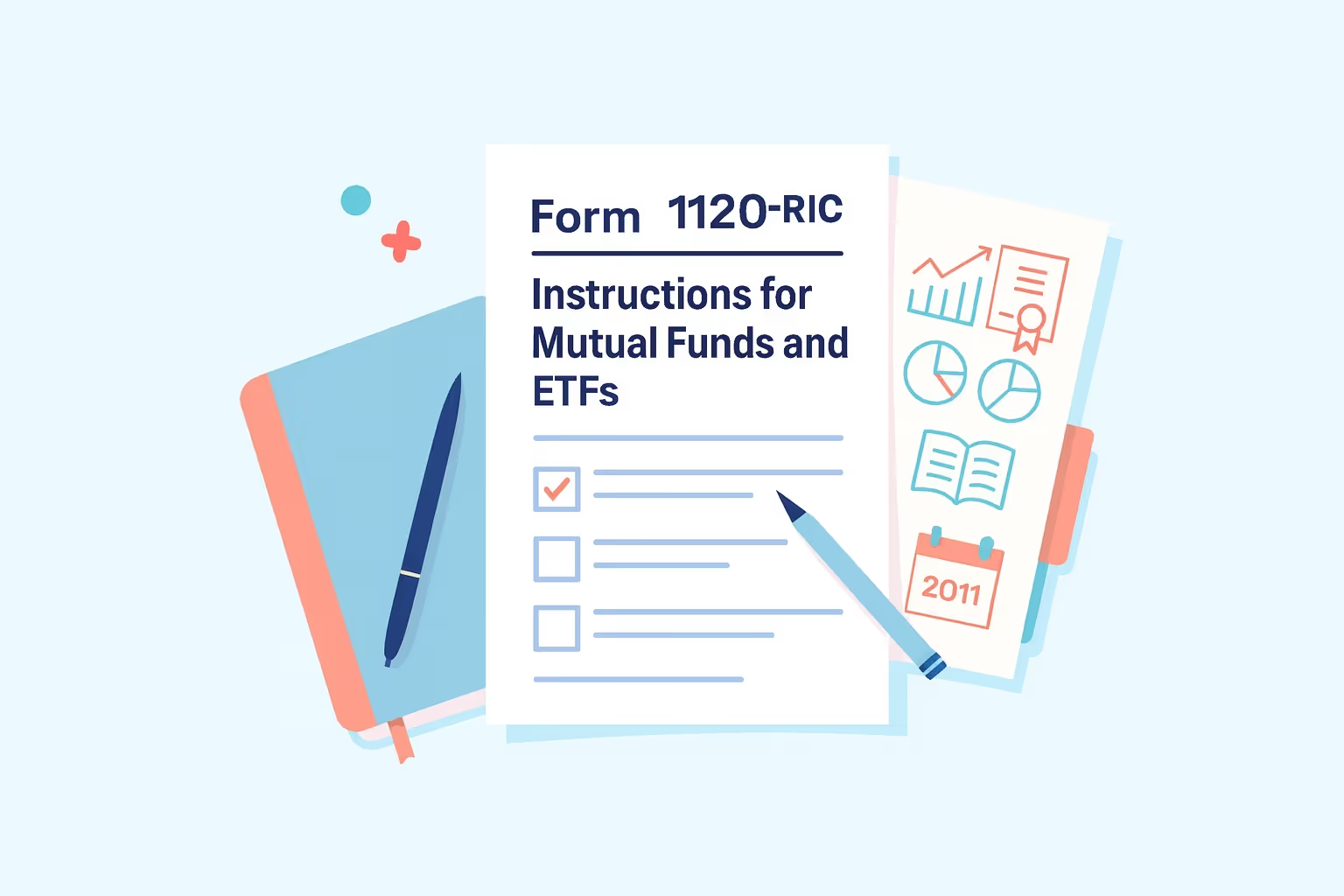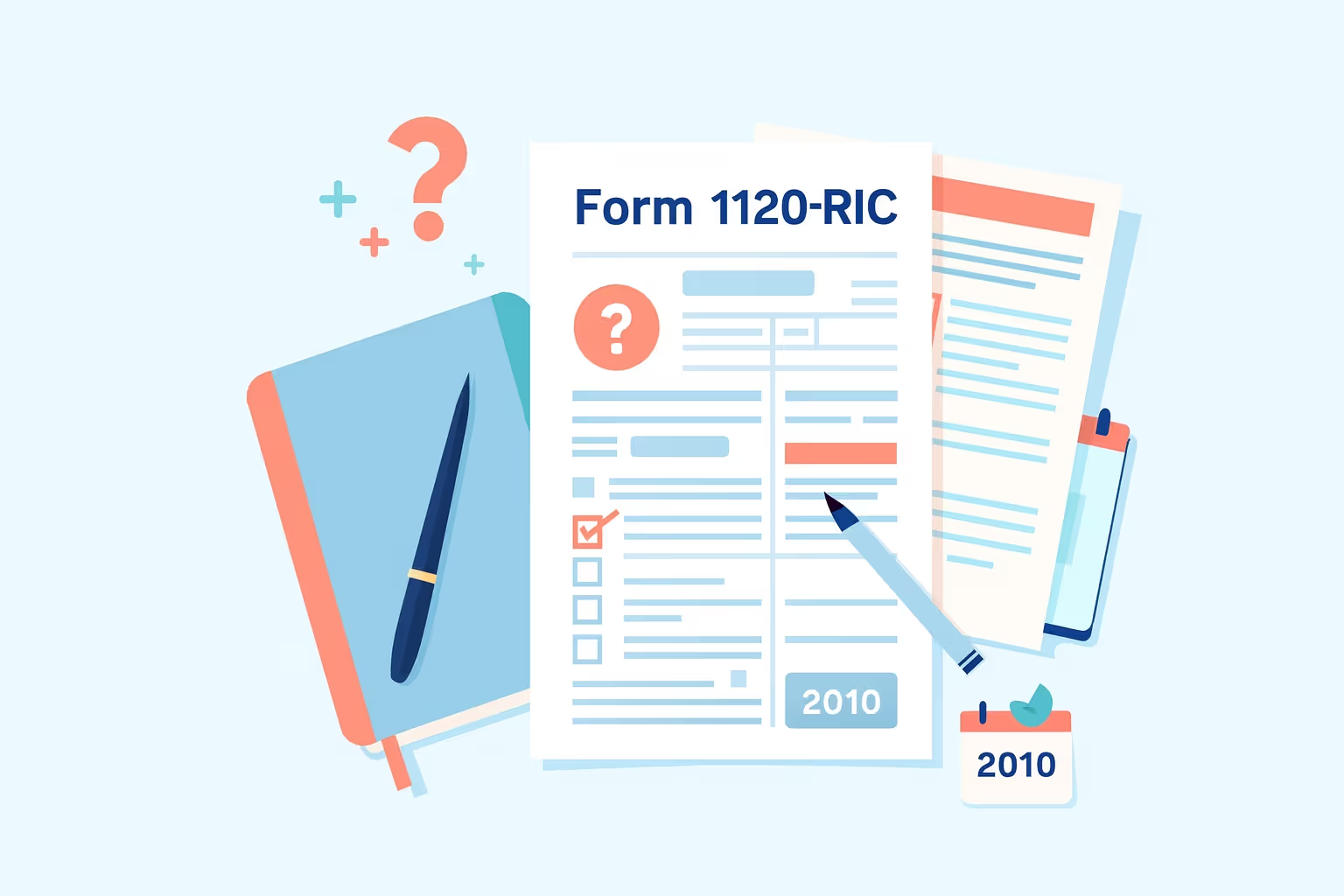Form 1120-RIC 2012 Instructions: How to File Correctly
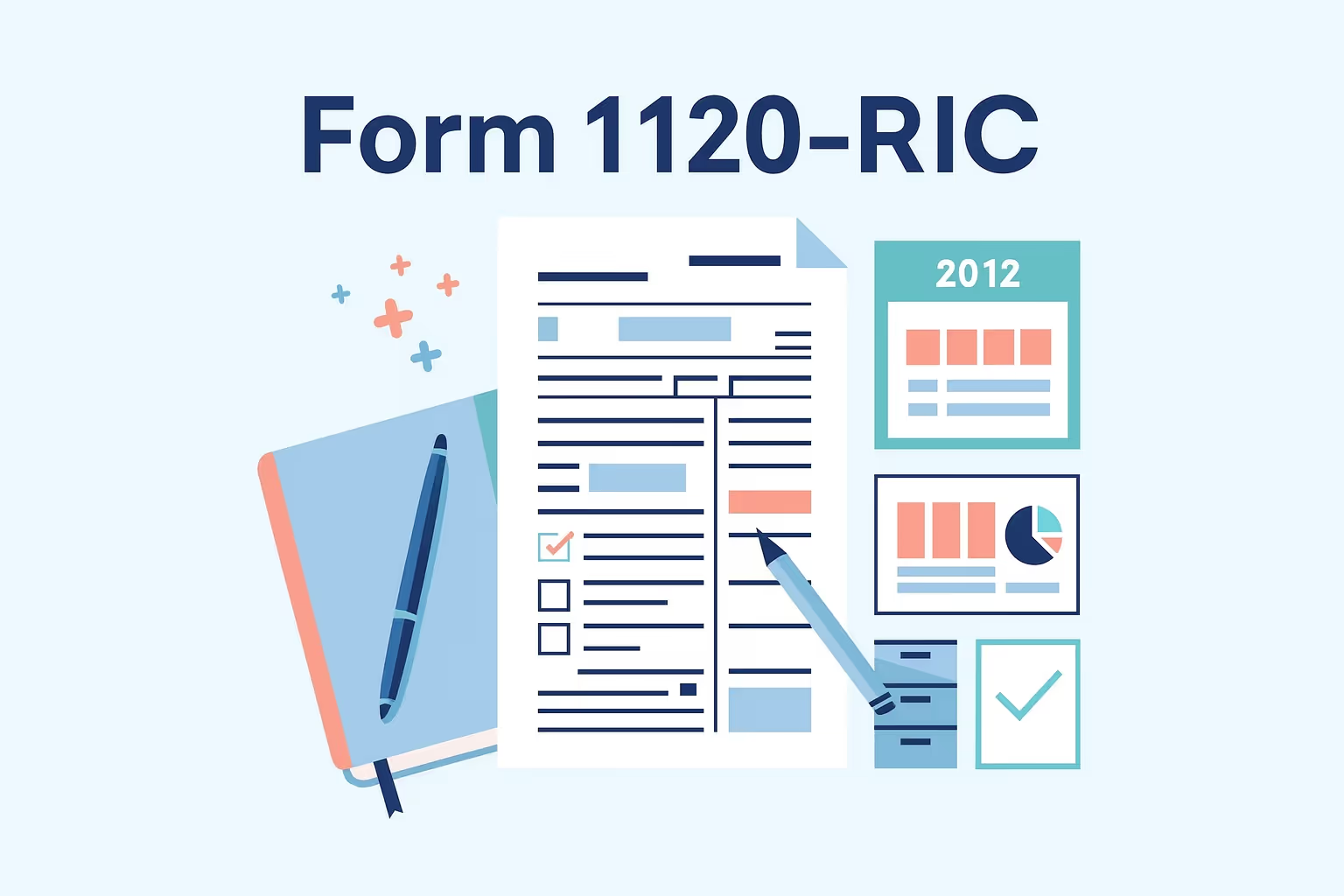
Form 1120-RIC (U.S. Income Tax Return for Regulated Investment Companies) is used by every domestic corporation that elects Regulated Investment Company (RIC) status under Section 851 of the Internal Revenue Code. The filing reports taxable income, investment company taxable income, and income tax liability, along with credits, adjustments, and other taxes. Each taxpayer must include the correct employer identification number, corporation name, and account information to ensure that all submitted details meet federal reporting standards.
The return for regulated investment entities applies to corporations that manage funds, such as mutual funds, exchange-traded funds, and similar portfolios. Each RIC must calculate its net income, reconcile data from the preceding tax year, and confirm that all records are properly documented and accurate. Filing a correct tax return for regulated companies supports proper RIC status election and demonstrates compliance with federal tax obligations. Maintaining precise records of salaries, compensation, and total assets supports transparency and accuracy.
The IRS 2012 Instructions for Form 1120-RIC require companies to review each page of the return before submission. This official IRS publication outlines filing requirements, computation steps, and signature verification procedures to help taxpayers prepare a complete and correct return.
Filing Requirements for Regulated Investment Companies
Regulated Investment Companies (RICs) must comply with detailed filing rules under Section 851 of the Internal Revenue Code. Form 1120-RIC (U.S. Income Tax Return for Regulated Investment Companies) applies to each domestic corporation electing RIC status. This election allows most income to pass through to shareholders for taxation purposes, rather than being taxed at the corporate level.
A corporation filing a tax return for regulated investment status must meet organizational and operational conditions. Each fund must be registered under the Investment Company Act of 1940 and be established primarily for investment. Proper recordkeeping ensures that all distributions, income, and account details remain verifiable.
To qualify and maintain RIC status, a taxpayer must meet specific requirements during the tax year:
- Income Test: At least 90% of gross income must come from dividends, interest, or gains from securities.
- Distribution Requirement: The company must distribute at least 90% of its investment company's taxable income to shareholders.
- Asset Diversification Tests:
- 50% Test: At least half of total assets must consist of cash, government securities, or investments in limited issuers.
- 25% Test: No more than one-quarter of assets may be invested in any single issuer or controlled group.
- 50% Test: At least half of total assets must consist of cash, government securities, or investments in limited issuers.
- Recordkeeping Obligation: Maintain detailed statements for taxable income, credits, and adjustments throughout the preceding tax year.
The taxpayer must submit Form 1120-RIC by the fifteenth day of the third month after the close of the tax year. Calendar-year filers must submit Form 1120-RIC by March 15 of the year following the tax year. Filing extensions may be requested using Form 7004, but all payments remain due by the original deadline.
Each return must include accurate identifying information. Key elements include the employer identification number, corporate name, mailing address, and total assets. The signing officer must verify accuracy, review each page, and ensure schedules and supporting documents are attached.
Accurate reporting supports ongoing RIC eligibility and consistent compliance. Maintaining correct data for compensation, salaries, shareholder distributions, and total tax strengthens transparency. Each corporation must ensure its filing reflects the proper income tax liability and investment company taxable income.
Meeting all filing requirements helps preserve RIC status and demonstrates accountability. A complete and accurate return reinforces trust, supports audit readiness, and ensures compliance with federal regulations.
Pre-Filing Preparation and 2012 Updates
Preparing an accurate Form 1120-RIC (U.S. Income Tax Return for Regulated Investment Companies) requires gathering financial data, verifying compliance, and reviewing changes introduced for the 2012 tax year. Each domestic corporation must confirm eligibility for RIC status before completing the return. Proper preparation ensures that every taxpayer meets reporting obligations, maintains accurate records, and submits a complete return reflecting actual investment company taxable income.
Pre-Filing Checklist and Key Requirements
- Confirm RIC Qualification: Each taxpayer must verify eligibility under Section 851. The corporation must meet income, asset, and distribution requirements and maintain detailed documentation throughout the preceding tax year. Qualification ensures proper recognition as a regulated investment company.
- Gather Financial Records: Collect account statements, shareholder distribution data, and records of net income, credits, and adjustments. Supporting documentation should include details of total assets, salaries, and compensation to confirm the accuracy of taxable income reporting.
- Verify 2012 Forms and Schedules: RICs must use the correct 2012 versions of Form 1120-RIC and related schedules. Using outdated documents or incorrect page formats can delay processing or cause compliance issues. Ensure that downloaded PDFs match the correct tax year before use.
- Electronic Filing Requirements: Any corporation with total assets of $10 million or more must e-file its income tax return. Electronic submission ensures faster confirmation and reduces errors during processing. Smaller RICs may also use e-files for convenience and accuracy.
- Set Up Federal Tax Payments: Register with the IRS Electronic Federal Tax Payment System (EFTPS) to make deposits and estimated tax payments. This secure platform supports the timely submission of business tax obligations and provides immediate transaction confirmation.
- Assemble Supporting Schedules: Prepare the required attachments, including balance sheets, income statements, and schedules that report the taxable income of the investment company. All forms must align with financial records to reflect accurate net income and income tax liability.
- Establish Contact Information: Ensure the employer identification number, mailing address, and phone number are correct. The officer signing the return must review all pages for accuracy and completeness before submission.
Proper preparation improves filing accuracy and minimizes risks associated with errors or missing data. Reviewing every section carefully ensures compliance with RIC qualification standards, accurate income reporting, and timely submission in accordance with federal requirements.
Step-by-Step Filing Instructions for Form 1120-RIC
Completing Form 1120-RIC (U.S. Income Tax Return for Regulated Investment Companies) requires precision and careful review. Each taxpayer must organize all supporting schedules, verify calculations, and confirm that financial details reflect the correct taxable income. Following these steps ensures full compliance with federal requirements and preserves RIC status under Section 851.
Step 1: Complete the Header Information
Enter the corporation’s legal name, employer identification number, and complete business address. Include contact details, such as the phone number and department extension, for any follow-up inquiries. Verify that the correct tax year, entity type, and RIC status election appear at the top of the form.
Step 2: Identify the Filing Period and Type of Return
Indicate whether the return covers a calendar or fiscal year. Use the appropriate tax period dates, ensuring they match internal records. Confirm that the company remains a domestic corporation and meets all filing requirements for the selected period.
Step 3: Report Income in Part I
Summarize all qualifying income sources. Include dividend income, taxable interest, and foreign currency gains. The total must accurately reflect the fund’s investment company taxable income and align with the preceding tax year’s financial statements.
Step 4: Record Deductions in Part II
List all deductible expenses directly related to business operations. Standard deductions include salaries, management compensation, repairs, and state taxes. Ensure that every deduction corresponds to a qualified business activity or service that supports the fund's operations.
Step 5: Compute Taxable Income
Subtract total deductions from gross income to determine taxable income. Review adjustments and carryovers from prior years to ensure accuracy. Reconcile these figures with the general ledger and balance sheet to confirm consistency.
Step 6: Calculate Tax and Credits
Use Schedule J to compute the total tax owed, including credits and other taxes. Verify that each credit is accompanied by supporting documentation. Record adjustments affecting income tax liability, ensuring every amount is correctly entered across all pages.
Step 7: Review Attachments and Schedules
Attach all required schedules, including Schedule A, Schedule K, and Schedule L. Confirm that investment company taxable income, total assets, and shareholder distributions match supporting statements. Each page must be clearly labeled and signed where required.
Step 8: Officer Verification and Signature
The signing officer must review all entries to confirm completeness and accuracy. Ensure the signature, title, and date appear on the final page. Retain a complete copy for corporate records and at least three years for reference.
Accurate preparation of Form 1120-RIC enhances compliance and minimizes the risk of correction requests. Following these structured steps supports proper reporting, timely submission, and continued recognition as a regulated investment company.
Filing Methods: Electronic and Paper Submissions
Regulated Investment Companies (RICs) must file Form 1120-RIC (U.S. Income Tax Return for Regulated Investment Companies) using the correct submission method. The choice between electronic and paper filing depends on total assets, organizational structure, and eligibility requirements. Selecting the appropriate method ensures timely acceptance, accuracy, and compliance with federal reporting standards.
The details below compares the key details, benefits, and requirements for each filing option.
Electronic Filing (E-File)
- Key Requirements: Mandatory for corporations with total assets of $10 million or more at the end of the tax year.
- Advantages:
- Reduces calculation errors through automated validation
- Provides faster processing and immediate acknowledgment of receipt
- Allows direct transmission of all pages, schedules, and attachments
- Where to File or Access: Submit electronically through IRS-approved e-file software or authorized providers.
Paper Filing
- Key Requirements: Available for corporations with total assets under $10 million or those exempt from e-filing.
- Advantages:
- Traditional format for corporations that maintain physical records
- Allows inclusion of original signatures and seals when required
- Enables manual review before mailing
- Where to File or Access: Mail completed forms and attachments to the designated IRS processing department, based on the business location and payment status.
Before submission, each taxpayer must verify every entry across all pages. Verify that taxable income, total tax, and credits match all supporting schedules. The signing officer should ensure all attachments, signatures, and supporting statements are properly arranged.
Larger corporations commonly use electronic filing because it improves efficiency and reduces errors. Paper filing remains an option for smaller entities that use manual preparation or lack access to electronic systems. Each method requires careful organization of schedules, accurate completion of income and adjustment sections, and precise identification of the corporation’s account details.
Every domestic corporation must retain a complete copy of the filed return, including all schedules and attachments. Accurate documentation supports audit readiness, demonstrates compliance, and verifies that the employer identification number and financial data are correct. Whether filing electronically or on paper, careful preparation and verification strengthen the accuracy of each regulated investment company’s tax return.
Payment and Estimated Tax Procedures
Regulated Investment Companies (RICs) must carefully manage federal tax payments to maintain compliance and avoid underpayment issues. Proper planning ensures timely deposits, accurate calculations, and transparent reporting of income tax liability. Each taxpayer must align payments with quarterly deadlines and verify that every transaction matches recorded taxable income.
1. Determine Total Tax and Liability
Begin by calculating the total tax based on the corporation’s taxable income. Include adjustments, credits, and other taxes reflected on Form 1120-RIC (U.S. Income Tax Return for Regulated Investment Companies). Review investment company taxable income figures from the preceding tax year to ensure all computations remain consistent.
2. Verify Prior-Year Data
Compare the current net income with figures reported in the previous year’s return. Reconcile any changes resulting from new income sources or amended schedules. Confirm that the total assets and tax obligations align with prior records to maintain transparent reporting.
3. Estimate Quarterly Payment Amounts
RICs expecting to owe $500 or more in tax must make estimated quarterly payments. Calculate each installment based on projected income, distributions, and credits. Ensure that total annual payments equal at least 100% of the preceding year’s tax liability or match the current year’s expected liability.
4. Schedule Deposit Dates
Quarterly payments are generally due on April 15, June 15, September 15, and December 15. Fiscal-year taxpayers should adjust their payment dates to match their filing period. Each deposit must be recorded and referenced in the company’s accounting system to verify payment history.
5. Submit Payments Electronically
All federal tax deposits must be made through the Electronic Federal Tax Payment System (EFTPS). This secure platform allows businesses to schedule transactions in advance and receive immediate confirmation. Maintaining EFTPS receipts provides proof of timely payment and supports accurate reconciliation during filing.
6. Record and Monitor Adjustments
Document any midyear changes in taxable income, distributions, or credits. Update financial statements and balance sheets to reflect each adjustment. Accurate tracking ensures consistency between quarterly payments and the final income tax return.
Effective management of payments and estimated taxes supports compliance with federal law. Maintaining organized records, verifying calculations, and adhering to deposit schedules strengthen the accuracy and reliability of every regulated investment company’s financial statements and returns.
Required Schedules and Supporting Forms
Every Regulated Investment Company (RIC) filing Form 1120-RIC (U.S. Income Tax Return for Regulated Investment Companies) must include accurate schedules and attachments. Each document provides essential details about the taxpayer’s financial activity, total tax, and income classifications. Submitting complete schedules ensures compliance, supports accurate review, and validates the reported taxable income of investment companies.
Core Schedules to Include
- Schedule A – Dividends Paid Deduction: Calculates the deduction for dividends paid to shareholders. This schedule verifies that the corporation meets the 90% distribution requirement for maintaining RIC status.
- Schedule J – Tax Computation and Payment: Summarizes total tax, credits, and income tax liability. Each entry must align with reported net income and adjustments across all pages of the return.
- Schedule K – Other Information: Captures additional data about the corporation’s business activities. The schedule also records qualifying elections, shareholder details, and investment classifications.
- Schedule L – Balance Sheets per Books: Lists beginning and ending balances for assets, liabilities, and equity. Each amount should reconcile with the general ledger and financial statements.
- Schedule M-1 – Reconciliation of Income (Loss) per Books: Explains differences between book income and taxable income. This schedule applies to RICs with total assets exceeding $25,000.
Supporting Forms and Documents
- Form 8613 – Return of Excise Tax on Undistributed Income of Regulated Investment Companies: RICs must use IRS Form 8613 to calculate and report the 4% excise tax on undistributed income. The form ensures compliance with Section 4982 requirements for the timely distribution of income and capital gains.
- Statement of Investment Company Taxable Income: Details income sources, adjustments, and credits used in computing taxable income. It must reflect accurate data drawn from supporting schedules.
- Schedule of Adjustments and Credits: Outlines all modifications that affect the total tax and income computation. Each entry must include a description and a corresponding figure.
- RIC Status Election Confirmation: Includes documentation confirming the corporation’s election and qualification under Section 851.
- Officer Verification Page: Contains the signature, title, and contact details of the authorized officer. This verification certifies the accuracy of every figure presented.
Submitting complete schedules and forms maintains consistency across financial statements and tax filings. Organized documentation demonstrates accuracy, confirms compliance, and strengthens the reliability of each regulated investment company’s return.
Compliance, Recordkeeping, and Common Filing Mistakes
Regulated Investment Companies (RICs) must maintain strict compliance with federal tax requirements to preserve RIC status under Section 851. Accurate recordkeeping and consistent reporting help confirm eligibility, reduce errors, and support audit readiness. Each taxpayer should follow a structured filing process to ensure that income tax liability and taxable income align across all schedules and statements.
Comprehensive documentation supports the accuracy of every Form 1120-RIC (U.S. Income Tax Return for Regulated Investment Companies). Records should include income statements, shareholder distributions, and balance sheets reflecting total assets. Retaining these materials for at least three years strengthens verification efforts during any IRS examination.
Common Filing Mistakes
- Incorrect Employer Identification Number (EIN): Submitting an incorrect EIN delays return processing and may affect the tax payment application. Verify all identifying details, including business address and department contact information.
- Omitting Required Schedules: Missing schedules or attachments cause inconsistencies in reported income, credits, and adjustments. Review each page carefully to confirm that all schedules, such as Schedule J or Schedule L, are included.
- Misreporting of Investment Company Taxable Income: Inaccurate reporting of taxable income results in discrepancies between book income and reported totals. Ensure that figures reconcile across statements and accurately reflect any necessary adjustments.
- Failure to Meet Distribution Requirements: Corporations that fail to distribute at least 90% of their investment company taxable income may lose RIC status. Track distributions throughout the tax year and document shareholder payments.
- Outdated Form Versions: Using obsolete or prior-year forms creates compliance conflicts and calculation errors. Always confirm that each PDF reflects the 2012 version before filing.
- Late Submissions or Payments: Filing after the deadline without an extension may lead to additional liabilities. Schedule reminders for both filing and payment dates to ensure the timely completion of all tasks.
Maintaining accuracy across every entry helps avoid correction requests and delays. Each corporation should reconcile all accounts, verify compensation figures, and confirm that adjustments are accurately documented and properly recorded. Organized files demonstrate compliance with RIC qualification requirements and support efficient review if the IRS requests supporting evidence.
A consistent compliance strategy helps sustain RIC recognition and ensures accurate reporting of investment income. Careful preparation, thorough recordkeeping, and diligent review contribute to a complete, credible, and fully compliant tax return. Maintaining detailed documentation for each filing period supports transparency and builds confidence during future audits or reviews.
Frequently Asked Questions
What is Form 1120-RIC U.S., and who must file it?
Form 1120-RIC U.S. is used by every domestic corporation electing Regulated Investment Company (RIC) status under Section 851 of the Internal Revenue Code. Each taxpayer must file an accurate income tax return if they meet the qualification tests for income, assets, and distributions. Corporations managing funds or investment portfolios must complete a tax return for regulated activities and include all required schedules, supporting statements, and signatures to confirm compliance with federal reporting standards.
How should a taxpayer handle missing information before filing an income tax return?
Before completing an income tax return, a corporation should verify every section for accuracy and completeness. If information is missing, the taxpayer must gather supporting records, such as wage statements, balance sheets, and prior filings. Providing additional details for each account or adjustment confirms accuracy. If errors are identified, they must be corrected before submission to prevent processing delays or future amendment requirements.
Are there penalties for late filing or payment of a tax return for regulated companies?
Yes. RICs that fail to file or pay on time may face penalties under federal law. These charges are based on the return’s submission date and the unpaid tax balance. To avoid issues, corporations should establish and adhere to payment deadlines, as well as maintain accurate records of all transactions. Consistent documentation, exact figures, and prompt filing help reduce the risk of added liabilities or compliance notifications from the Internal Revenue Service.
How do regulated investment companies report wages and compensation?
Corporations filing a return for regulated investment status must report all wages, salaries, and compensation on Form 1120-RIC U.S. Each entry should reflect amounts paid to officers, employees, and fund managers. Supporting schedules must align with payroll records and include detailed classifications for each payment. Accurate wage reporting ensures proper deduction eligibility and consistency between the tax return, financial statements, and year-end employee reporting forms.
What role does a social security number play in filing Form 1120-RIC U.S.?
The social security number identifies officers authorized to sign the return and verify its accuracy. It must match IRS and company records to validate the filing. The number is required for signature authorization and is not used as a substitute for the employer identification number. Corporations must ensure the information remains secure and consistent across all sections, including contact data, notifications, and supporting documents.
What should a parent corporation include when filing on behalf of a subsidiary?
A parent company filing on behalf of a subsidiary must provide complete documentation for both the parent company and the subsidiary. This includes consolidated income data, asset reports, and supporting schedules. Each return must accurately reflect account balances, detailed investment classifications, and provide notifications for all distributions. Maintaining a clear separation of records for each entity ensures compliance and prevents discrepancies in reporting during federal reviews or reconciliations.
When is the filing deadline for calendar-year RICs?
Calendar-year filers must submit Form 1120-RIC by March 15 of the year following the tax year. For example, returns covering the 2012 tax year were due March 15, 2013. Fiscal-year corporations must file by the fifteenth day of the third month after their year-end, such as November closings. Meeting deadlines supports timely processing, prevents late fees, and confirms the corporation’s continued qualification as a regulated investment company.
















